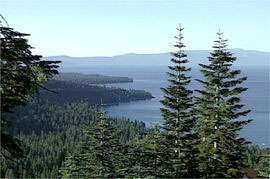Lake Tahoe Clarity Holds Steady in 2005

The waters of Lake Tahoe were clear to an average depth of 72.4 feet in 2005, according to UC Davis scientists who have monitored the lake since 1968. That keeps the clarity measurement in the range where it has been for the past five years -- and where it was for other multiyear periods in the 1990s.
When measurements began in 1968, a white "Secchi disk" lowered into the lake was visible at an average depth of 102.4 feet.
Lake Tahoe clarity varies from year to year because precipitation varies. That affects the amount of soil particles and pollutants that are washed into the lake, said John Reuter, associate director of the UC Davis Tahoe Environmental Research Center (TERC). And that makes it difficult to use data from any single year or even a small number of years to draw conclusions about whether the lake is improving overall or getting murkier.
Experts believe the fine particles and nutrients that fuel algae growth are causing the loss of clarity in Lake Tahoe. The particles and nutrients enter the lake through erosion, runoff and atmospheric deposition. Clarity is directly affected by the scattering of light by fine particles and by the absorption of light by algae.
UC Davis researchers measure the lake's clarity with a Secchi disk every seven to 10 days at two fixed locations. The depth at which the white disk, the size of a dinner plate, disappears from sight is referred to as the Secchi depth.
UC Davis and many other academic institutions and public agencies are working together to restore and preserve the Tahoe Basin ecosystem. Led by the Tahoe Regional Planning Agency, all are currently engaged in producing an unprecedented set of environmental management plans for the basin, called Pathway 2007. UC Davis scientists emphasize that restoration efforts led by local, state and federal land managers in the Tahoe Basin are focused on the long term, and evaluating success cannot be made on the basis of any single year's results.
Recently, UC Davis' TERC scientists, in cooperation with California and Nevada water quality protection agencies, developed another mathematical model for use in guiding Tahoe Basin restoration efforts. Called the Lake Clarity Model, it can simulate the lake's response to various combinations of pollution types and amounts.
The annual average Secchi measurements for the past several years were:
-- 2005: 72.4 feet (22.1 meters)
-- 2004: 73.6 feet (22.4 meters)
-- 2003: 71 feet (21.6 meters)
-- 2002: 78 feet (23.8 meters)
-- 2001: 73.6 feet (22.4 meters)
-- 2000: 67.3 feet (20.5 meters)
"While this year's clarity number is encouraging, the annual measurements remind us how crucial it is to stay the course in our efforts to restore Lake Tahoe and to preserve it for future generations," said Julie Regan, communications director of the Tahoe Regional Planning Agency.
Source: UC Davis





















